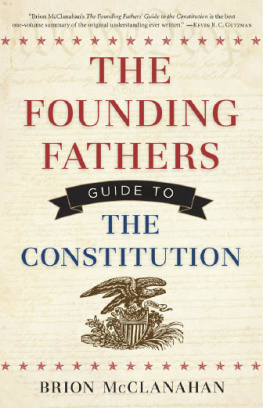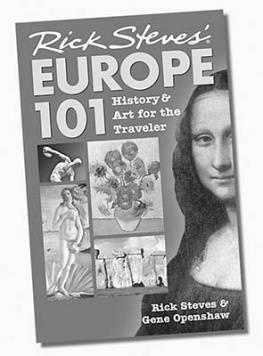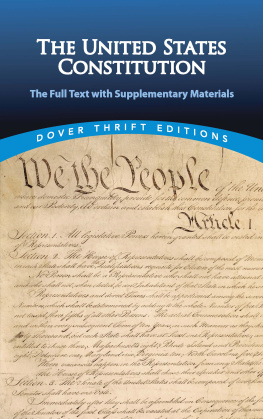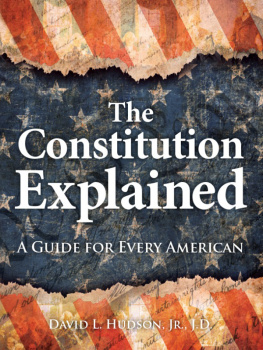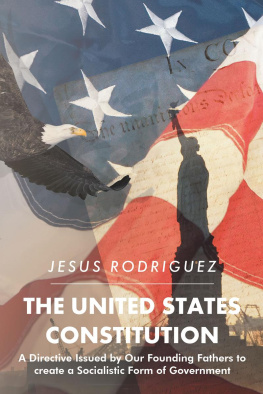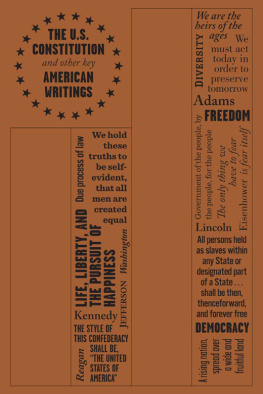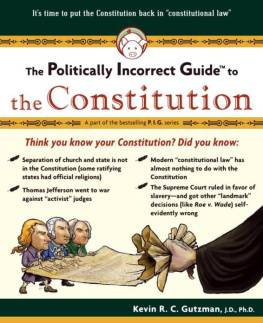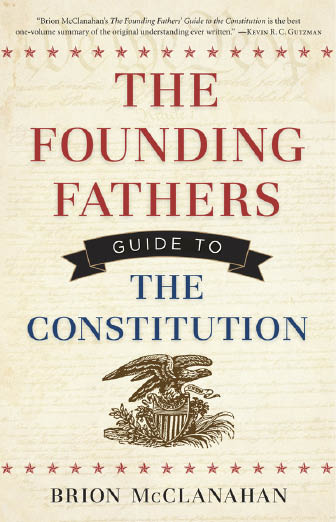All rights reserved. No part of this publication may be reproduced or transmitted in any form or by any means electronic or mechanical, including photocopy, recording, or any information storage and retrieval system now known or to be invented, without permission in writing from the publisher, except by a reviewer who wishes to quote brief passages in connection with a review written for inclusion in a magazine, newspaper, or broadcast.
McClanahan, Brion T.
The Founding Fathers Guide to the Constitution / Brion McClanahan.
p. cm.
1. Constitutional historyUnited States. 2. United States. Constitutional Convention (1787) 3. Founding Fathers of the United States. I. Title.
Regnery Publishing, Inc.
Books are available in quantity for promotional or premium use. Write to Director of Special Sales, Regnery Publishing, Inc., One Massachusetts Avenue NW, Washington, DC 20001, for information on discounts and terms or call (202) 216-0600.
Introduction
B oth the Left and Right claim the Constitution and its meaning as their own. Leftists like to cite the elastic clauses of the Constitution while conservatives often call it a limiting document. But how did the founding generation view the document, particularly when it was being sold to the States for ratification? What did the Preamble mean to them? How did they define the powers of Congress, the president, and the federal court system? And what about the so-called elastic or sweeping clauses of the Constitution? Does the Left have a case, or is the Constitution a limiting document as the Right suggests? The battle over the Constitution and its meaning cuts to the heart of the United States polity.
The story of how the Constitution came to be is well told. Following the American War for Independence, the central government under the Articles of Confederation proved too weak to handle the tasks of the Union. There was internal discord (particularly in Massachusetts), State paper currency was worthless, taxes were too high, treaties were unenforceable, and the commercial relationships between several States were strained at best. The Union seemed to be in peril and open to a foreign invasion. As a result, several leading men in the StatesAlexander Hamilton and James Madison foremost among themadvocated calling a convention to discuss changes to the Articles.
They first met at Annapolis in 1786, but delegates from only five States showed up, and they were powerless to make any substantial recommendations to the United States Congress. They instead called for a new convention to meet in Philadelphia in May 1787 under the guise of amending the Articles of Confederation. Fifty-five men from eleven States attended, among them some of the most distinguished names in American history, including George Washington and Benjamin Franklin. Many were shocked to learn that Madison and Hamilton did not want to amend the Articles, but instead wished to start over with a new governing document. Madison, through fellow Virginian Edmund Randolph, presented the famous Virginia Plan to the Convention in the opening week. This plan scrapped the Articles, created a new national government with supreme legislative, executive, and judicial branches, and truncated the powers of the States. For his part, Hamilton preferred that the States be abolished altogether and advocated that both the executive and the members of the upper house in the national congress be elected for life. Neither Hamilton nor Madison would have his wish, and the document they would be forced to defend during the ratification process barely resembled the ambitious plans each man wanted when the Convention began.
During that hot summer in 1787, the members of the Philadelphia Convention hammered out in secret deliberations what Catherine Drinker Bowen called the Miracle at Philadelphia. The end result was a document littered with compromises, the most important being one between the small States and large States. Everyone at that time, however, knew that those terms were nothing more than code words for a national centralized government versus a federal decentralized government. That part of the story is often omitted, but it was the real battle. As the Constitution moved to the States for ratification, the great debate was whether we should have a national or a federal government. The Constitution created a stronger central authority, as its proponents wanted, but it also had limitsand it was the central governments limits that were sold to an otherwise reluctant public. Most Americans would not have accepted ratification had the Constitution not been presented as a plan for a strictly limited government. That is the key to understanding the Constitution.
Some say the Constitution cannot be understood at all. In December 2010, liberal columnist Ezra Klein said, The issue of the Constitution is that the text is confusing because it was written more than 100 years ago, and what people believe it says differs from person to person and differs depending on what they want to get done. But neither of these critiques is right.
Certainly, Chernow is correct that the founding generation vigorously debated the meaning of the Constitution, particularly when it was sent to the States for ratification. But, in contrast to his assertion that Americans cannot arrive at a founding interpretation, a clear consensus can be gleaned from these debates. We know how the founding generation interpreted the various provisions of the Constitution because we can read what they said. The Constitution is not ambiguous or difficult to understand. Of course, the trappings of power and, at times, practical political problems altered views of the Constitution, even in the founding generation, but this did not change the meaning of the Constitution as ratified . The record is clear. The way proponents of the document defended it is the way it should be interpreted. Unfortunately for men like Klein and Chernow, that interpretation does not often mesh with their vision for American government. It never has for progressives.
A few definitions are in order. Which of the Founding Fathers are included in The Founding Fathers Guide to the Constitution ? The answer is simple: all of them. In addition to James Madison and Alexander Hamiltonthe two members of that generation who, because of the Federalist Papers, are often cited as the true expositors of the documentothers, such as James Wilson, Patrick Henry, Luther Martin, Roger Sherman, Elbridge Gerry, George Mason, William Richardson Davie, James Iredell, Oliver Ellsworth, Melancton Smith, John Dickinson, Charles Pinckney, John Rutledge, and Robert Whitehill, are frequently cited for their contributions to the debate. Some were both members of the Philadelphia Convention of 1787 and their State ratifying conventions. Others took part only in their State conventions, and others, such as Tench Coxe and Richard Henry Lee, took part in neither but provided critique and analysis of the Constitution and its provisions. They were all part of the debate over ratification and, as such, it was their Constitution.

